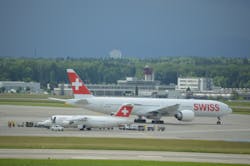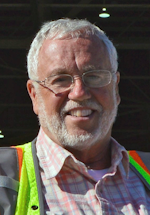For any airline, the introduction of a new aircraft type is a major event, involving cost, a learning curve, and the adjustment to new operating realities. Swiss International Airlines (SWISS) has significantly increased that equation by bringing two new types into the fleet simultaneously, with preparations and planning ratcheted up accordingly.
The airline began operations April 1, 2002 following Swissair’s (SR) demise at midnight on March 31st. The new Swiss national carrier was created using the corporate structure of the former Swissair associate airline, Crossair (LX). The newly established carrier created a fleet from its own existing aircraft and a portion of the now-idle Swissair aircraft. That meant former Swissair MD-11s and A330-200s for the long-haul routes, and assorted members of the A320 family, Avros (BAe RJ-100s), Saab 2000s, and ERJ-145s were available for European services. In 2005, SWISS was purchased by Lufthansa and is now part of the Lufthansa Group, though it maintains a separate management structure.
Swissair had also operated its own maintenance facility, which also did a large volume of third-party maintenance work. Cognizant of the potential that could be tapped by making the operation more independent, in 1997 Swissair spun off SR Technics as a separate company within the Swissair Group. When Swissair failed, SR Technics was transferred to new owners, who began to expand its operation across the globe. Despite this reordering of the Swiss aviation scene, SWISS continues to use SR Technics as its primary partner.
The MD-11, for which Swissair had been a launch customer, was used initially, but was not an ideal choice and beginning in June 2003, SWISS began to replace them with A340-300s, creating a fleet that peaked at 15 aircraft. The A330-200s were also replaced with A330-300s, which provided more seats at a similar operating cost. In Europe, the regional jets and turboprops disappeared, the A320 group was tweaked and the Avros soldiered on.
The Search for a Replacement — with London City Capability
But these Avros had accumulated quite a few cycles — one was over 20 years old. They were also an older technology and were somewhat fuel thirsty; yet they remained because they had a vital capability — the ability to operate from London's City Airport (LCY). Nonetheless, the search for a replacement was undertaken and, after considerable research SWISS and the Lufthansa Group opted for the still-in-development Bombardier C Series (CS100). The aircraft offered the necessary range/payload requirements and, most importantly, could operate from LCY.
The commitment to the C Series has had some challenging moments as the aircraft fell far behind schedule and financing wore thin. The folks at SWISS were candid in their worries as to whether or not the aircraft would a) ever come to be and b) live up to promised specifications. Yet now, as the number of aircraft in service continues to grow, the wait and the investment appear to have been vindicated.
They Whys and Hows of the Transition
I spoke with Martin Apsel-von zur Gathen, head of network management at SWISS, who detailed the ways in which the transition was being handled and what the expected benefits were for SWISS. The Lufthansa Group has most recently aligned its network management among the four hubs, Frankfurt, Munich, Zurich, and Vienna. Long-haul planning is performed in “virtual teams” consisting of a planner from each hub, whose task is to align their network offer with the goals of the group as a whole. By doing so, competitive advantage is optimized. Taking San Francisco, my home airport as an example, Lufthansa operates an A380 in the early afternoon to Frankfurt and a late evening A340-600 to Munich while either a SWISS A340-300 or B-777-300ER leaves early evening for Zurich. This is supplemented for much of the year with twice-daily flights by joint venture partner United, operating an afternoon and evening flight to Frankfurt. Ideally, a Star Alliance flyer should be able to connect anywhere in the world by utilizing this buffet of choices.
When asked why SWISS chose the Boeing 777-300ER (77W) rather than the cutting edge technology of the 787 or A350 series, Martin explains that the airline began by searching for a 300+ seat aircraft that met the payload and range performance required by SWISS. Along with passenger considerations, SWISS continues to generate significant revenue from cargo, and therefore any aircraft chosen needed to meet full payload requirements over the airline’s longest routes. Both the 787-9 and A350-1000 would have been payload restricted on some routes over a portion of the year and the A340-600, while meeting the airline’s needs, was a technological step backwards. The new 77X was too long a wait and therefore the 77W hit the sweet spot in terms of requirements — and it was readily available within the desired timespan.
In terms of available seat cost, the 77W will offer a 20 to 25 percent reduction in comparison with the A340-300, with most of that reduction found in fuel cost and maintenance. It also allows SWISS to grow its capacity on prime routes by boosting seats from 219 on the A340-300 to 340 on the 77W (55 percent) without adding additional aircraft. Efficiency is further boosted by the fact that SWISS has one of the world’s highest utilization rates for its long haul aircraft — about 18 hours per day.
Some A340-300s Will Remain
But the 77W is not a one-to-one replacement for the A340. Currently, there are 10 77Ws to be added: six are currently in the fleet, while four will be added in 2017/18, clearly short of the 15 A340-300s recently operated. SWISS will continue to operate the A340 for the foreseeable future as some of the aircraft are relatively new and will continue to fill the needs for intercontinental routes with lower seat demand. The airline’s six leased A340s will be the first to leave the fleet. Three of the owned aircraft will be transferred to Edelweiss Air, a Swiss/Lufthansa Group subsidiary which operates scheduled seasonal services to 40 worldwide destinations.
C Series Plusses
At the other end of the spectrum is the CS100, designated to replace the RJ100 fleet on European routes. Aircraft were to be integrated at the rate of approximately one per month through 2018 and the Avro fleet was to be reduced in a similar fashion. However, unforeseen delays in the delivery of the aircraft’s Pratt & Whitney PW1524G engines has meant that aircraft are arriving at a slower rate than anticipated.
The airline has 30 units on order and the first 10 will be the CS100 model (125 seats) with aircraft 11-25 being the larger CS300 (145 seats). The final configuration of the last five will be determined at a later stage based on market conditions and demand.
Unit cost reduction from the ARJs is anticipated to be around 25 percent and 10 to 15 percent with respect to the A320 fleet. The trip cost is seen to be about 15 percent below that of the ARJs and 10 to 15 percent below that of the A320. The C Series aircraft will offer both Business and Economy service but will not have fixed compartments. For Business Class, two of the five seats per row will be unoccupied.
Having flown the aircraft in a Bombardier configuration, I found the seating to be comfortable in a standard five abreast configuration with windows much larger than those found on aircraft of a similar size. The engines provide ample power and the aircraft surprisingly has transoceanic range. All of this is done with significant reductions of NOX and CO2 as well as having a greatly reduced noise footprint — a vital factor for operations in noise-conscious Europe.
More Crew as Well
And then there is the human component, crew. In the case of the B77W, a cadre of 220 cockpit personnel is being trained to fly the aircraft. Candidates for training are accepted from all aircraft types currently operated. In order to give trainees as many cycles as possible, the 77Ws are being deployed on numerous European segments, allowing more flight opportunities for those transitioning. For the summer of 2016, the new planes were deployed on regular scheduled services to Hong Kong, Bangkok, and Los Angeles with San Francisco, Sao Paulo, and Singapore brought online as additional aircraft arrive. Tokyo, Johannesburg, and Beijing will remain, for the near term, A340-300 destinations.
The increased passenger numbers carried by the Boeings will also increase the demand for cabin staff. The airline is currently seeking up to 800 new applicants for cabin crew positions as well as the additional cockpit crew — a difficult task in a rapidly expanding aviation marketplace where crew of all sort are in increased demand. SWISS, like Swissair before it, has a group of freelance cabin staff (aushilfe) that work part-time as demand requires. They are fully certified but choose to fly only part time and provide a handy way to expand cabin staff in peak periods.
In terms of the existing European fleet there are 10 A320-neo and 5 A321-neos on order that are intended as replacements for existing aircraft of the same type. The wet leased F100s, operated by Helvetic will be replaced by E90s operated by the same carrier and the Q400s, operated by partner Austrian Airlines, will continue to augment the fleet for short-haul, low-density destinations. With the growing fleet of the C Series aircraft, the A319 aircraft will be eliminated. At the end of 2016, the SWISS operated European fleet numbered 64, growing to 66 (including wet leased aircraft) by the end of 2018.
A Changed and Expanded Maintenance Program
While all line-maintenance tasks up to A-checks continue to be preformed by SWISS Technics, a division of the airline, all other checks, as well as base maintenance, are contracted with SR Technics. However, with an expanded workload for SWISS technics, they have leased hangar space from SR Technics — three bays for short haul aircraft and four for long haul.
The SWISS Technics staff, along with all other departments in the airline, was challenged by the simultaneous integration of two new fleet types. However, the entire process was achieved with no major complications.
Part of the transition has included new training and upgrading of skills for roughly 300 employees and engineers. In addition, roughly 100 new staff will be added to SWISS Technics to handle the growing fleet.
Newer, Better, Lower Cost
This is a huge undertaking for a midsized airline. Within about three years 39 aircraft will be replaced with models new to the fleet, completely revamping the European and ultra-long haul services. When the transition is fully implemented, SWISS will have more capacity, lower costs, and one of the youngest fleets in Europe. Though many think of chocolate when Switzerland is mentioned, the equally famous Swiss reputation for excellence and precision will doubtless continue to make the transition flawless.
Ron Kuhlmann has spent his entire life in the aviation industry. Beginning with a 30-year career at Swissair, he moved to an aviation consulting firm which eventually was absorbed by Unisys Transportation. He has written for numerous aviation publications and has been a speaker at industry events, including being the keynote speaker for Lufthansa Systems' global meeting in Berlin.




